On September 2nd 2015 the Tibetan government-in-exile celebrated its 55th ‘Democracy Day’ with the usual grandiloquent speeches about how much the Tibetans owe the Dalai Lama and how much the government has achieved in exile. For Penpa Tsering, the Speaker of the Tibetan parliament-in-exile, the occasion was also an opportunity to remind Tibetans who in his words, “…have moved and who continue to move to other countries – with the result most of them become scattered…”, of the importance of them voting in the upcoming Sikyong and general elections, into which Penpa has also thrown in his candidacy.
Penpa Tsering’s comment may seem casual to outsiders but to the Tibetan people in exile, it represents an acknowledgement that a ‘pact’ amongst the Tibetan refugees, forged out of a common commitment and bound by a common belief, has fallen apart. The Tibetan exiled leadership known as the Central Tibetan Administration (CTA) has traditionally held that the Tibetan people should remain as refugees and fight to eventually return home to genuine freedom in Tibet. To refuse to remain stateless and without an identity hints at disloyalty. This combined with 60 years of stagnating CTA policies has resulted in the Tibetan exile community becoming the oldest refugee community in the world with no sign of that status changing soon.
However, it is not so much that increasing numbers of Tibetans are restless and seem to have relinquished the cause. More significantly, it is who has given up the fight and where they have moved to that sounds the loudest warning to all who continue to believe in the Tibetan dream. The recent Sunday edition of the South China Morning Post ran a news piece that reported that a Dalai Lama insider has essentially de-camped the Tibetan cause and become a Chinese citizen, “Dalai Lama’s former biographer takes up residence in mainland China.”
Amchok Rinpoche was the personal biographer of the Dalai Lama. As such, he was counted as a member of the Dalai Lama’s inner circle and moved amongst the Tibetan social and monastic elite; he was privy to the latest undisclosed news and developments. His decision therefore to jump ship took many by surprise and is definitely worth noting. To the public, the CTA portrays itself as a liberal society against China’s oppressive totalitarianism that constantly challenges human rights provisions. If that is true, then it has to be asked why anyone would choose to give up a life in relative freedom, to trade it in for what is supposed to be a tyrannical regime that is accused of violently opposing Tibetan Buddhism. Surely not an aging monk and a senior member of the Dalai Lama’s own community.
The Writing In On The Wall
Amchok Rinpoche’s defection can mean a number of things from the benign to the sinister:
(1) Like many Tibetans who went into exile with the Dalai Lama, he is now an elderly person in his 70’s. Most Tibetans have expressed the desire to live out the rest of their lives in their homeland, and set aside all worldly aspirations and nationalistic pursuits. For Amchok Rinpoche, his return to Tibet may be as simple a reason as that – after fifty years in exile, Amchok Rinpoche’s view is towards his next time and his preparations for his passing on hallowed land now, this desire now overriding nationalistic fervor
(2) All is not well within Dharamsala and after half a century, those like Amchok Rinpoche finally acknowledge that the Tibetan people will never win the freedom that the CTA has been promising for five decades. Realising this, Amchok Rinpoche has decided to abandon all hopes in the Tibetan leadership, in favour of a more comfortable life in China. This loss of faith should not come as a surprise when the CTA is notorious as a corrupt government that busies itself with internal politicking and personal gains, instead of looking after the welfare of the Tibetan people.
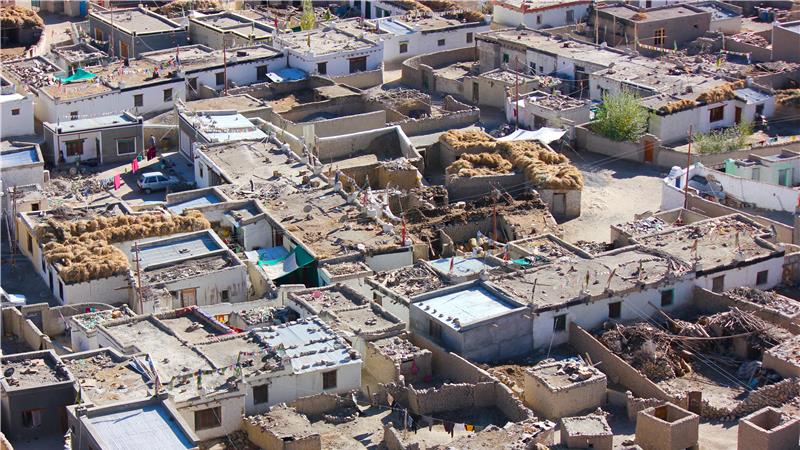
Tibetan settlement in India. Socially and economically, it is obvious that not much progress has been made in relations to the welfare of the Tibetan people since they went into exile.
It is the decaying values of the CTA that prompted United States Congressman Dana Rohrabacher to issue a stern and official warning to the CTA stating amongst other things, “…[the US Congressman is]…also aware of serious accusations that US funding meant for Tibetans may have been misspent… If US assistance has been misspent and perhaps even goes into the pockets of the Communist Chinese and Tibetan power brokers I will learn of it and action will be taken.”
Thus, with his insider’s knowledge of what really happens in the CTA, Amchok Rinpoche’s faith in the leadership’s ability to achieve their goals was finally extinguished, leading to his departure for China. After all, how can a perverted CTA undertake such a task which took the likes of Mahatma Gandhi an entire life of commitment to achieve?
(3) The Tibetan community in exile under the CTA cannot sustain itself let alone preserve the rich culture, tradition, language and spirituality of old Tibet. Recognising this, Amchok Rinpoche may have decided to seek greener pastures elsewhere.
Five decades of CTA mismanagement has thrown Tibetan society (and therefore the Tibetan cause, whatever that may be) in chronic disrepair. For all the aid that has been amassed by the various Offices of Tibet, Tibet Fund, International Campaign For Tibet and similar Tibetan organizations (private and public) around the world, the Tibetan people have not progressed socially, economically or politically.
If the main objective of leaving Tibet was to escape supposed oppression, and to live and thrive in the largest democracy of the world and work from there to regain their nation, then for the Tibetan people that objective is now purely moot. How does the CTA define ‘thriving’ when tens of thousands of their own people have no choice but to live in dilapidated refugee camps? How does it benefit the Tibetan cause for the Tibetan people to suffer high unemployment rates, or an inability to vote, buy a house, or register and start a business? How does it benefit the Tibetan exile community to suffer all of this while the rest of the world streak ahead?
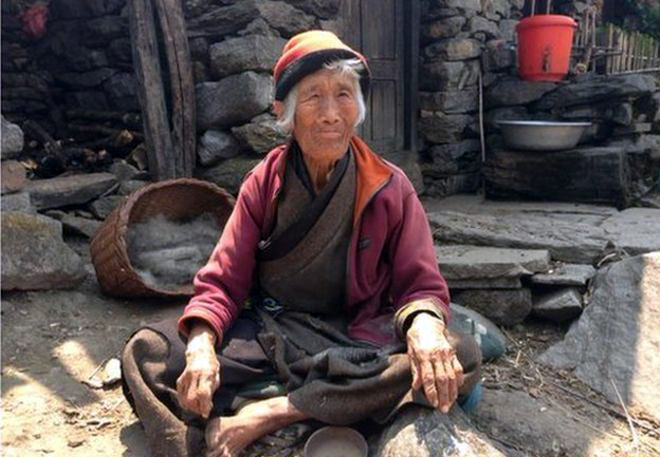
An octogenarian Tibetan refugee in Brindi Village, Nepal, forgotten by the CTA.
And all things considered, the Tibetan refugees in India actually have it good compared to their counterparts in Nepal. In Nepal, Tibetan refugees are all but invisible to the world although they number in excess of thirty thousand. The Nepali government refuses to acknowledge them for fear of provoking the ire of China, and the CTA conveniently forgets about them.
How can this heavily afflicted community of people hope to fight their way back into freedom if their leadership so easily forgoes their welfare when it becomes inconvenient? If the CTA cannot even care for 150,000 Tibetans with five decades’ worth of international aid, how can the same CTA negotiate the freedom of six million Tibetans and thereafter govern them?
(4) China, more so than the CTA is serious about preserving the Tibetan culture, identity and spirituality. Amchok Rinpoche’s move to China came after decades of observing China (he first visited in 1982) and witnessing how the Asian giant has come to embrace Tibetan Buddhism. At the same, China is initiating projects to preserve and assimilate the Tibetan culture into the greater Chinese identity.
Even before the Tibetan language was made available in refugee schools in India, China had already made the language compulsory for schools in the Tibetan Autonomous Region. In the years after Mao’s rule, the Chinese Communist Party seems to have changed its approach. Regardless of whether this change in approach is motivated by a sincere appreciation of Tibetan culture and religion, or it is laden with strategic political considerations to win the Tibetan people over, the fact remains that the Tibetan people, culture, standard of living and religion fare much better under the Chinese government. Political sentiments aside, this is a fact.
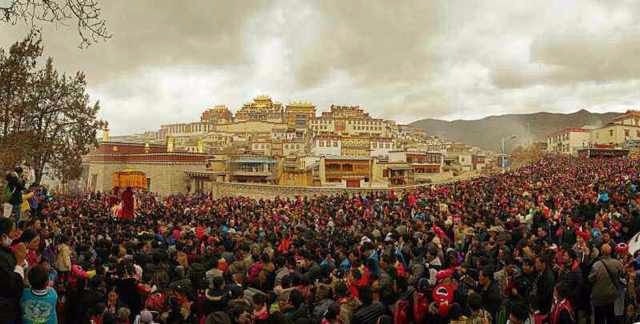
Tibetan Buddhism is thriving in China’s Tibet.
In contrast and for all that they claim to be doing, the CTA’s results fall short of even the bare minimum required to defend the Tibetan way of life in exile. The Tibetan refugee camps are proof of this. The Tibetan people as well as their culture continue to fall prey to modernity and the ineptitude of its defenders. Whether the Tibetans like it or not, their culture and religion are exposed to greater threats due to the CTA’s mismanagement rather than to China.
In the meantime, what were once pure Buddhist traditions that survived millennia now face dilution to find a place in foreign cultures. Perhaps in the end, even traditional hardliners like Amchok Rinpoche had to admit this and chose to work to help the Tibetan people from within by going back to China.
(5) The Tibetan Cause is a lost cause.What is unique about the ‘Tibetan Cause’ is that the longer it is around, the less well-defined it becomes and the less people know what they are actually fighting for. It becomes a blind vocation when the CTA demands that their people commit to a cause the CTA itself cannot describe. That ultimately renders the fight, hollow of conviction and short-lived.
From firm believers in the fight for independence, that purpose was quietly mortgaged away by the Dalai Lama in June 1988 for what he had thought the Chinese would agree to, which is self-autonomy (or as he named it, the ‘Middle Way’). The problem was that the Dalai Lama miscalculated the Chinese resolve and over-estimated Western support. In redefining the Tibetan Cause as the Middle Way (instead of independence), the primary reason the Tibetan people remained as refugees for decades became lost and exhausted.
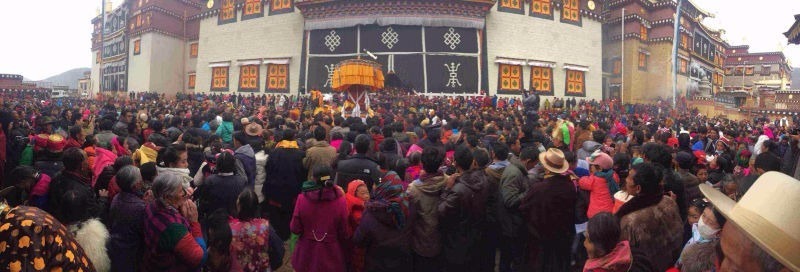
The pure Tibetan Buddhist lineage being preserved in Tibet under Chinese stewardship.
Finally just when the Tibetan people were about to reconcile with the fact that the Tibetan Cause was no longer independence, Sikyong Lobsang Sangay too sold that away in Washington and stated that the CTA would agree to communist rule (http://www.phayul.com/news/article.aspx?id=33551). In any case, the ‘Tibetan Cause’ in all its chimerical manifestations has become a storm in its own teacup as the new Chinese Premier Xi Jinping has stated unequivocally that he will agree neither with Tibetan self-autonomy or Tibetan independence. In the meantime, the Dalai Lama’s popularity and political currency wanes as China waxes into world economic domination.
In Conclusion
The CTA has proven conclusively that opposing China without economic or military might, and without any long-term ally in the West has not and cannot work. On the other hand, China has expressed openness to engage with any Tibetan who is willing to set aside all political content and advocacy of the Dalai Lama’s ideas. The condition that the Tibetan people’s livelihood, language, culture and religion are inextricably linked to the CTA’s feudalistic politics is solely the creation of the Tibetan leadership, and not the Chinese leadership. In order for the CTA to fulfill their own interests, they gambled away the entirety of the Tibetan people’s cultural and spiritual inheritance. It was only a matter of time before patience wore thin and frustrations grew.
To leave Dharamsala for greener pastures fulfills the needs of various groups of people. For self-serving people looking out for their own interests, leaving Dharamsala to start building a future elsewhere reflects a lack of faith in the Tibetan leadership’s ability to provide a future in Dharamsala. For those who remain loyal to the CTA, leaving Dharamsala may be an opportunity for them to gather information from inside Tibet to feed back to the Tibetan leadership.
For those who simply want a quiet, peaceful place to retire, leaving Dharamsala takes them away from the directionless, dogmatic politicking that has come to characterise the Tibetan leadership in recent years. Whatever a person’s reasons for leaving are, it does not reflect well on the CTA.
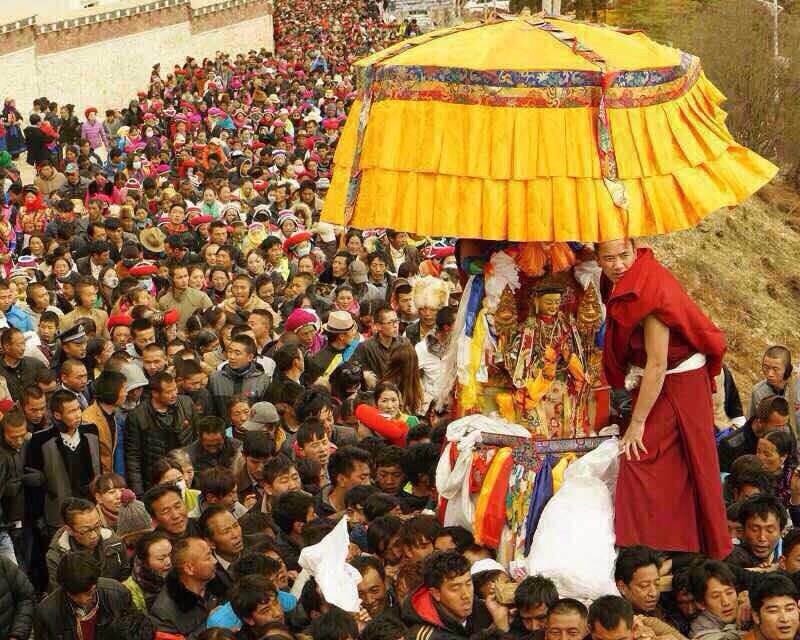
The Chinese Communist Party supports the propagation of Tibetan Buddhism so long as Buddhism is not used as a political tool.
Amchok Rinpoche’s decision to accept citizenship in China is not the first, and it foreshadows the people’s distrust of the CTA and a future where more ordinary Tibetans decide to take matters into their own hands. For certain, no true democratic government (as the CTA claims to be) would have been allowed to run the people’s lives and their future to the ground, and not be held accountable.
Having said that, we can now expect the CTA to respond with a barrage of accusations and counter-claims. One that is already making its way amongst netizens is that this story is yet another manufactured propaganda by the Chinese and that Amchok Rinpoche was tricked into colluding with this story. However this would be highly unlikely as Amchok Rinpoche visited China in 1982, lived in China for a year in 1987 and visited Tibet several times since then. Having spent so many years in China, he would have become well-versed in the modus operandi of the Chinese leadership and understood how his visits will be publicised. Is it possible for Amchok Rinpoche to have colluded so many times with the Chinese, and risked being used as propaganda? Surely then he should have known better, and visited China less often so as to prevent himself from being used as propaganda against the Dalai Lama.
After all, it is the Dalai Lama whose biography he was working in and it would be in his best interests to protect the subject of his works. Having worked closely with the Dalai Lama’s Private Office, Amcok Rinpoche would also have been well aware of the political maneuvering of both sides and would not so easily fall into a trap.
It has been speculated that Amchok Rinpoche has been sent to infiltrate the enemy of the Tibetan people, China. That would infer that the Chinese government’s fear of the Dalai Lama’s separatist activities have a basis and that is why the Chinese have refused to negotiate until such gamesmanship and espionage cease altogether. However, this is unlikely to be the reason why Amchok Rinpoche has defected due to his age and his high visibility to both sides of the divide; espionage would be more effectively carried out by a lower profile individual.
Whatever Amchok Rinpoche’s reasons are to defect, it is certain that the CTA has over the half century supplied many reasons for the Tibetans, Chinese and observers to doubt its capability if not its integrity. Perhaps it is time, the CTA face up to the hard truth that the game is over for them.
Tibetan
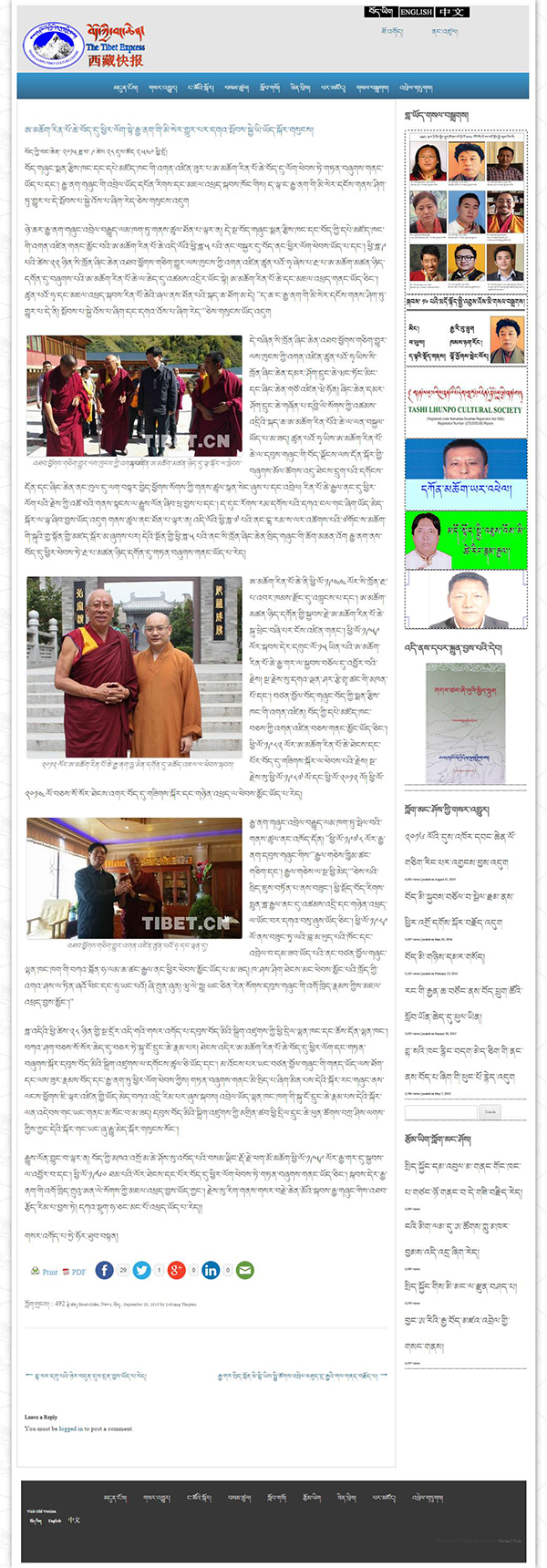
Click to enlarge (Source: http://bangchen.net/achok-rinpoche-returned-to-tibet-settle/)
English

Click to enlarge (Source: http://www.scmp.com/news/china/policies-politics/article/1861793/dalai-lamas-former-biographer-takes-residence-mainland)
Chinese

Click to enlarge (Source: http://www.tibet.cn/news/focus/1443276477544.shtml)
In the Media
The news of Amchok Rinpoche’s defection is now being publicised on Chinese media.
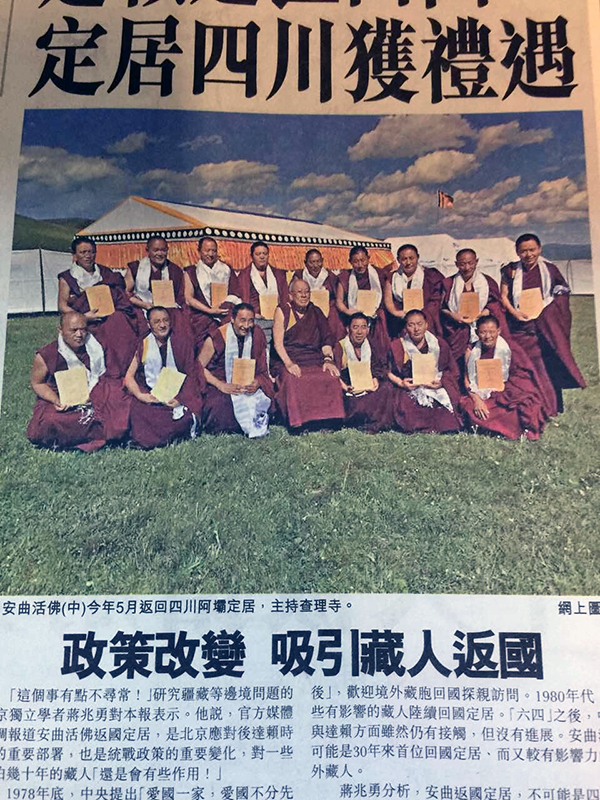
Click to enlarge
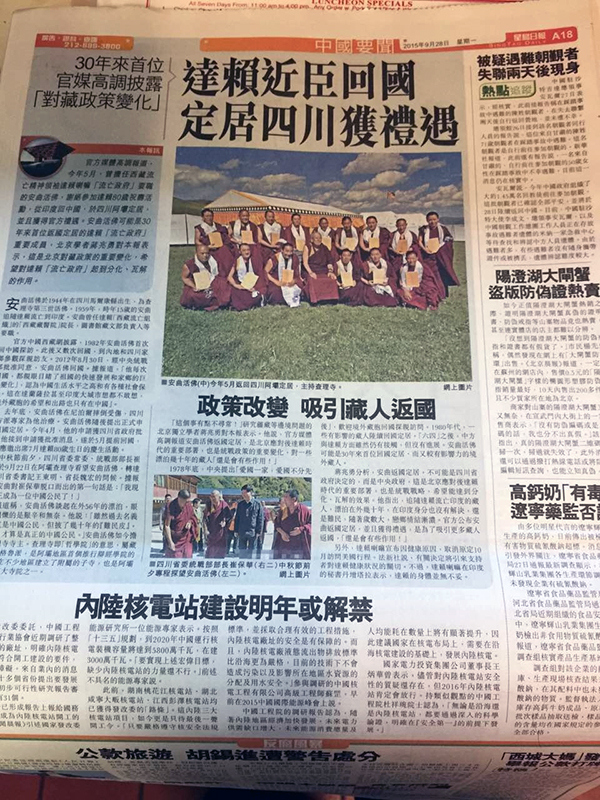
Click to enlarge
English Translation
Left column (starting at the light blue box):
Dalai’s Close Official Returned to Settle in Sichuan, Receiving Mark of Courtesy
Official media widely reported that in May this year, Achok Rinpoche who has served key positions in the exiled Tibetan Spiritual Leader the Dalai Lama’s “Government In Exile”, declined to participate in the Dalai Lama’s 80-year-old birthday celebrations, returning from India to China, to settle in Aba Sichuan, and receiving mark of courtesy from the government. Achok Rinpoche could be the first important member of the Dalai Lama “government in exile” to return home in 30 years. Beijing’s scholar, Jiang Zhaoyong told this newspaper that “this is an important change in Beijing’s policy on Tibet, and I hope this will play a role in dividing and splitting up Dalai Lama’s “government in exile”.
Achok Rinpoche was born in Sichuan, Markam County in 1944. He is the third incarnation, associated with Tsanney Gompa. In 1959, when he was 15 years old, Achok Rinpoche followed the Dalai Lama into exile in India. Achok Rinpoche served as director for the Dalai Lama’s “Government In Exile” Tibetan Medical & Astrological Institute, director for the Library of Tibetan Works and Archives and other key positions.
The official China Tibet website reported that Achok Rinpoche first visited China in 1982. Since then, he has returned to the mainland several times to visit relatives and friends in his hometown in Sichuan. On August 30th 2012, receiving approval from the Central United Front Work Department, Achok Rinpoche came home. According to reports, “every time he returned home, he witnessed tremendous changes in the rapid development of the motherland and his hometown,” he also thinks that the Chinese high standard of living and a variety of social security are such that even those living in Dharamsala or in the big Indian cities do not dare to dream about, and “the only hope and way out for overseas Tibetans is only in China.”
Late last year, Achok Rinpoche had injured himself from a fall. The Sichuan government sent experts to treat him. Achok Rinpoche subsequently filed a formal application to reside permanently in China. In April, his application was approved by the Sichuan Provincial Government. He received the news that his application was approved and returned early in May, not attending the the Dalai Lama’s 80th birthday celebrations although he was invited.
On the eve of Mid-Autumn Festival, Sichuan Provincial Committee and Head of the United Front Work Department, Cui Baohua visited Achok Rinpoche in the Aba Tsanney Gompa on September 22nd, conveying greetings from Sichuan Provincial Party Committee’s Wang Dongming, and Sichuan Province Governor Wei Hong. According to reports, the first words that Achok Rinpoche blurted out when meeting Cui was: “I am truly a Chinese citizen now!”
It was reported that when Achok Rinpoche spoke about his wandering life of 56 years, his eyes had flashes of hardship and helplessness. He said, “While in the past I have been a Chinese citizen in name, but I was wearing the coat of ‘refugee’ for decades. Today, I am considered a real Chinese citizen.” Achok Rinpoche is the current abbot of Tsanney Gompa.
Tsanney means “institute of philosophy”. It is one of the monasteries of the Gelug Sect of Tibetan Buddhism, and the first monastery in Aba to implement debate. It has also established subsidiary monasteries in many areas, and it is one of the three major monasteries in the Aba region.
Middle column (under the main headline):
“This is a bit unusual!” said Jiang Zhaoyong, a independent Beijing researcher on Mongolian, Tibetan and other ethnic issues, who said that extensive reporting of the return of Achok Rinpoche reflects Beijing’s preparation to deal with the post-Dalai Lama era. This also shows the important policy change of the United Front and that this “will have some effects” on Tibetans who have been wandering for decades.
By the end of 1978, the central government promoted “All patriots belong to one big family, whether they rally to the common cause early or late”, welcoming visits by overseas Tibetan compatriots to return home for visits. In the 1980s, some influential Tibetans have continued to return to settle in China. After the Tiananmen Square Protests, although China is still in contact with the Dalai Lama, there has not been any progress. Achok Rinpoche may well be the first influential overseas Tibetan to return home in 30 years.
Jiang Zhaoyong also said that Achok Rinpoche’s repatriation could not have been determined by the Sichuan Provincial Government alone. It was the decision of the Central Government, and it is an important preparation by Beijing to deal with the post-Dalai Lama era, as well as United Front’s strategy in hopes to divide and split up the Dalai Lama’s “government in exile” in India. He also mentioned that the Tibetans who exiled together with the Dalai Lama have been wandering for decades, and that their Indian identity issue has not been resolved. They are still refugees and as they age, the longing to return to homeland gets stronger. The official announcements of the repatriation of Achok Rinpoche and of him receiving the mark of courtesy from the local government, “will have some effects!” to attract more Tibetans to repatriate.
In addition, the Dalai Lama announced that due to health reasons, the trip to the United States in October is cancelled. Agence France-Presse said that the decision would lead to concern about the Dalai Lama’s health from his supporters. However, the Dalai Lama’s secretary Tenzin Takla, said that there is nothing wrong with the Dalai Lama’s health.
Update
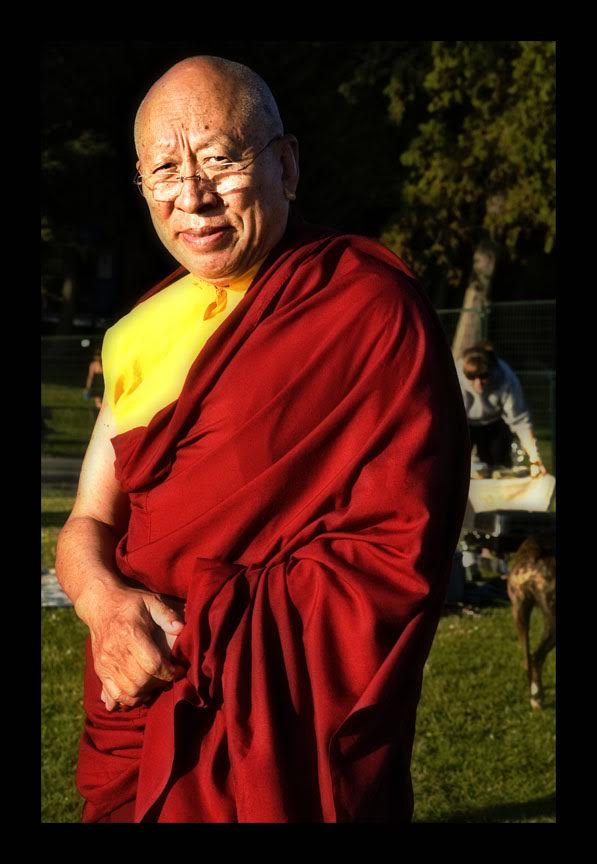
Amchok Rinpoche
Recently during His Holiness the Panchen Lama’s first and historic Kalacakra initiation on 21 July 2016 in Shigatse, Tibet, the abbot emeritus of Ganden Shartse Monastery, Amchok Rinpoche attended the first few days of the event. There, he made a spiritual and karmic connection with the Panchen Lama.
Amchok Rinpoche’s background is quite interesting as he is a scholar, known for his literary skills in Tibetan and is a recognized reincarnated Tulku from Amdo, Tibet. This is actually the same area from which the Dalai Lama comes from. After completing his Geshe studies at Ganden Shartse Monastery in South India, he proceeded to Dharamsala and worked at the Library of Tibetan Works and Archives (LTWA). He was very close to the Dalai Lama and worked as his personal Tibetan biographer. He would often be summoned by the Dalai Lama to attend various rituals and sermons.
He resided in Dharmasala for nearly two decades, after which he was appointed the abbot of Ganden Shartse Monastery, where he resided during his tenure. Following the completion of his tenure, he returned to Dharamsala to be near the Dalai Lama and his government, the Central Tibetan Administration (CTA).
However, in a recent and stunning turn of events, Amchok Rinpoche declared that his root Guru was none other than Kyabje Trijang Rinpoche. He went to the Chinese embassy in Delhi and he received his visa to travel to China within one day. He packed up his belongings and flew to China where he was well-received and granted Chinese citizenship immediately. Amchok Rinpoche had a few students in Ganden Shartse, South India. Those who happened to be Geshes have, since then, also left India for Tibet and China.
Amchok Rinpoche is a strong disciple of Kyabje Trijang Rinpoche and a practitioner of Dorje Shugden. For many years he had to keep his practice a secret as he lived in Dharamsala, near the Dalai Lama. Like many other people, he paid lip service to the Dalai Lama in order to feign giving up Dorje Shugden’s practice. However, he did not in fact do so. It is said within the Tibetan communities all over the world and even in the three great Monasteries of Ganden, Sera and Drepung, that many still practice Dorje Shugden. They do not see the purpose of banning Dorje Shugden. Rather than bringing unity, the ban has only brought further disparity to an already fragmented society.
Many Tibetans, even those outside of the monastic communities, who traditionally have not had a connection to Dorje Shugden practice, now whisper among themselves about the ban having no purpose and bringing no benefit to the Tibetan people. Evidently, Amchok Rinpoche tired of hiding his practice and decided that enough was enough. He packed up his belongings and literally defected to China.
More and more Geshes and scholars as well as ordinary monks are tired of the ban. They know there is nothing wrong with Dorje Shugden. They have to feign giving up the practice although they continue in secret. They see the blatant persecution against practitioners who are open about their worship of Dorje Shugden. They cannot reconcile with the turmoil that they see within the Tibetan communities. Therefore, many of them just like Amchok Rinpoche have opted to defect back to China. Surprisingly, they escaped China for freedom but the freedom they sought in India was nothing but farce since they were under the oppressive regime of the CTA (Tibetan government-in-exile located in Dharamsala). So they decided to defect back to China.
Amchok Rinpoche has been very well-received in China, in his monastery and also among his peers. China has really opened her arms up for him. He has set an example for many other Tibetan lamas, Geshes, scholars, teachers and ordinary folk, showing them that if they returned back to Tibet, their lives will be much better, they will have freedom of religion and practice.
He was recently seen attending the Panchen Lama’s Kalacakra initiation, which would have irked the CTA leadership in Dharamsala. From the side of those who continue to support the CTA, there has been no comment regarding this high-profile defection of someone close to the Dalai Lama, his own personal biographer. No doubt this would have embarrassed the Dalai Lama, who has remained silent over the issue. As time goes on, we will see that what China and Tibet has to offer is so much better than what the Tibetans living in the refugee communities of India are given. India affords every freedom for the Tibetans, except for religious freedom which is curtailed by the CTA.
It seems that Amchok Rinpoche will not, cannot and refuses to give up his practice of Dorje Shugden and for this purpose has defected back to Tibet. This is the latest update on Amchok Rinpoche. We wish him well for his bravery and integrity.
MORE NEWS LIKE THIS